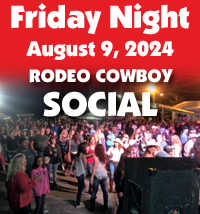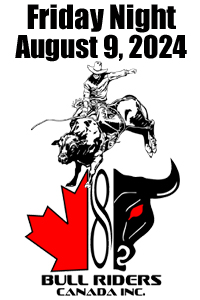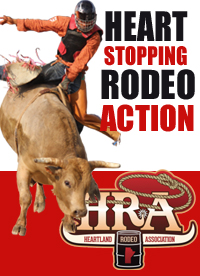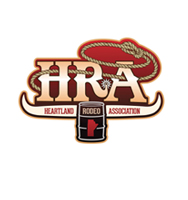
Not Sure What "Rodeo" is all about?
Below are descriptions of some of the events...
Steer Wrestling
Steer wrestling is a big man’s sport. Winning runs may be done in four or five seconds. In steer wrestling there are many factors: horses, the steer and the rider. The steer wrestler has a helper called the “Hazer”. The steer wrestler starts from behind a barrier. He has to know how to judge cattle so he can avoid getting a ten second penalty for breaking the barrier before the steer. If the steer gets too much of a head start, the steer wrestler will not be able to catch him. The steer wrestler comes down on the left side of the running steer, must stop its forward and take it down. To be scored for a legal run, the steer must be thrown on its left side with all four feet straight out. While the steer wrestling is very fast event, it is also a very complex event and all things have to be done right in order to have a winning run.
Goat Tying
Goat tying is a fast-paced rodeo event. The object is to race to the end of the rodeo arena to where a goat is staked out on a 10' rope (The distance from the starting line to the stake is usually 100 feet or so.). Contestants dismount their horse while it is sliding to a stop or running and race to the staked-out goat, which must be flipped to its side, in order to tie together three of its legs with a leather, nylon or cotton rope. Finally, contestant signals with their hands to indicate the end of their run. The contestant with the fastest time wins. There are penalties that may be added to the run at the judges’ discretion such as a disqualification if the goat becomes untied during the 5 second tie period and 10 seconds added to a time for the horse crossing the staked rope.
Tie Down Roping
Tie down roping is a rodeo event that features a calf and a rider mounted on a horse. The goal of this timed event is for the rider to catch the calf by throwing a lariat around its neck, dismount the horse, run to the calf and restrain it by tying three legs together in a short time. This event comes from the work of actual cowboys who catch and restrain calves for branding or medical treatment.
Bareback
A wild eight second ride on a bucking horse without a saddle, rain or stirrups! It is probably the most demanding event on a contestant’s body. As in all riding events, the score is based on half the animal’s performance and half on the rider’s. A contestant wants a strong bucking horse that jumps and kicks hard, and also changes direction. Since half of the points are from the horse it is an important factor in the over all score. When watching a bareback ride, look for a contestant that spurs the horse in the shoulders and then spurs up to his hand holds in his rigging. A good bareback ride is when a contestant does this on every jump. A very important rule in saddle bronc and bareback is when the rider has to mark out the horse. This means the first time that the horse’s front feet hit the ground, the rider must have both feet over the break point of the shoulders and touching the animal. When a cowboy has a good horse and a good spur ride that’s what counts the most.
Team Roping
Also known as Heading and Heeling, team roping is a rodeo event that features a steer (typically a Corriente) and two mounted cowboys. On one side of the chute is the header whose job is to rope the steer to the left. On the other side of the chute is the heeler whose job is to rope the steer around the hind legs. The header must rope the steer with one of three legal catches: clean horn catch (around both horn), a neck catch (around the neck) or a half-head catch (around the neck and one horn.) The header then takes a dally, that is a couple of wraps of the rope around the horn of the saddle. The heeler waits until the header has turned the steer. When he has a clear way, he throws a loop of rope under the running steer’s hind legs catching them. As soon as the steer is stretched out an official waves a flag and the time is taken.
Saddle Bronc
Saddle bronc riding is the cornerstone of rodeo, a combining a good bucking horse and a skilled rider. As with all riding events, the horse and rider are marked separately. For a good saddle bronc horse, look for a horse that kicks high every jumps and bucks consistently throughout the entire ride. Judges like this type of horse and even more if this horse changes direction a lot of times during the ride. Another type of horse that will get marked fairly high, will be a horse that ducks and dives, but also keeps kicking in this action. Look for a good rider that spurs the horse high in the front end and then in a flowing motion spurring back to the cantle of the saddle. High marks for the saddle bronc rider are awarded for spurring, so judges have to make sure that the contestant has spur contact with the horse and that he just isn’t “polishing his boots.”
Bull Riding
Bull riding is one of the most exciting events in rodeo action and danger all in one package. As tough as it is, riding the bull is the easy part. Where it gets hard is when a bull rider gets jerked down on to the bull’s head or gets stepped on and run over by the massive beast. The score is based on 50% for the rider and 50% for the bull. The rider’s score is usually about the same as the bull, give or take a couple of points depending upon control. It is very important for a bull rider to draw a high ranked bull. Bull riding is more than just brute strength and hanging on! Good bull riders have a good hold on the bull with their spurs and that takes the power away from the riding hand. When the bull jumps and hits the ground it will probably move the rider’s feet back forcing him to get a new hold with his spurs. Beside the hustle with his feet, a bull rider must use his free arm to balance himself during the ride. A good bull rider makes moves with his free arm in front of his body. If the bull rider makes his free arm move behind his body, he will get strung-out on the bull and probably get jerked down on the bull’s head. Beside the skill of riding bulls, there is more mental preparation in bull riding that any other event. A bull rider knows what can happen, but has to clear that out of his mind when he gets ready to ride. Bull riding is about 25% talent and 75% mental. This is what separates the average bull riders from the good ones. It may sound a little strange but you have to want to get on bulls and enjoy it!
Ladies Barrel Racing
Ladies barrel racing is an event of speed and good horsemanship. The rules of barrel racing are very simple - complete the cloverleaf pattern the fastest. In the ladies barrel racing there is a score line set up about 30 feet away from the first two barrels... it is at that point that the contestant starts and finishes. Once crossing the scoreline, the contestant must make a cloverleaf pattern on the three barrels. Besides the speed that a barrel horse must have, the horse must have a good rein and be able to change leads as it begins its turn around the barrel.
Gymkhana
Potato Race
Contestants will have to hurry to the other end of the arena while on their horse, pick up a potato and deposit it into a pail and continue down to the finish line.
Magazine Race
Contestants will have to go to the end of the arena where there will be some magazines. Contestants will be told only after starting their ride which page to retrieve and then return it to the starting line.
Barrel Racing
Same rules as the official barrel racing.
Juice Race
Riders are required to bring a straw to their partner at the opposite end of the arena. The partner uses the straw to drink all of the content of a juice box, hands the empty juice box to the rider who races to the finish line.
Obstacle Course
Contestants will be required to go through an obstacle course without touching the boards. The contestants will be assessed a maximum of two penalties for incomplete obstacles and one penalty maximum for touching any board in the obstacle. After finishing the obstacle course the rider has to cross the finish line for their time to stop.
Cutting
The challenge to select a single calf from the herd... gently guide it into the center of the arena... and then, with lightening fast starts and turns, prevent it from ducking past the horse and escaping back to the herd.
In the contest arena, the art of the cutting horse comes alive in a classic test of intelligence, training, breeding and skill. Many factors play a part in the making of a cutting champion.
In competition, the cutting horse and rider must work together as a team in demonstrating their cattle-handling skills. The contest begins as the pair approaches the herd. Quietly. Deliberately. And without hesitation. The horse and rider have two and one-half minutes to complete their work.
Approaching the herd, both horse and rider must concentrate on moving into the cattle to separate one animal from the herd without provoking disturbance. Performance is judged in part by the activity of the calf, so the animal selected is singled out by choice, not at random. After the rider has indicated a specific calf to the horse, neither horse nor rider may change calves without penalty. When the cut is complete, the challenge really begins.
Once the calf is isolated near the center of the arena, the rider must loosen his rein to allow the horse freedom to demonstrate its cutting skill and real "cowsense". Controlling the calf by speed, agility, balance and motion, the horse matches the calf move-for-move to prevent its return to the herd (the calf's natural inclination.) A true champion is trained to react instinctively to the calf's movements without the need for direction. A loose rein is one of the keys to a highly marked performance.
Although the contest time limit allows two to three animals to be cut, the time spent with each calf is left to the rider's discretion. The horse may "quit" the calf without penalty when the calf is obviously stopped or obviously turned away from the cutting horse. But if a calf is "lost" under any circumstance, a 5 point penalty is assessed. Even a good performance can end with a low score if a calf escapes the horse's control.
Each judge submits a score ranging between 60 and 80 with a score of 70 being average at the end of the contest period.
















